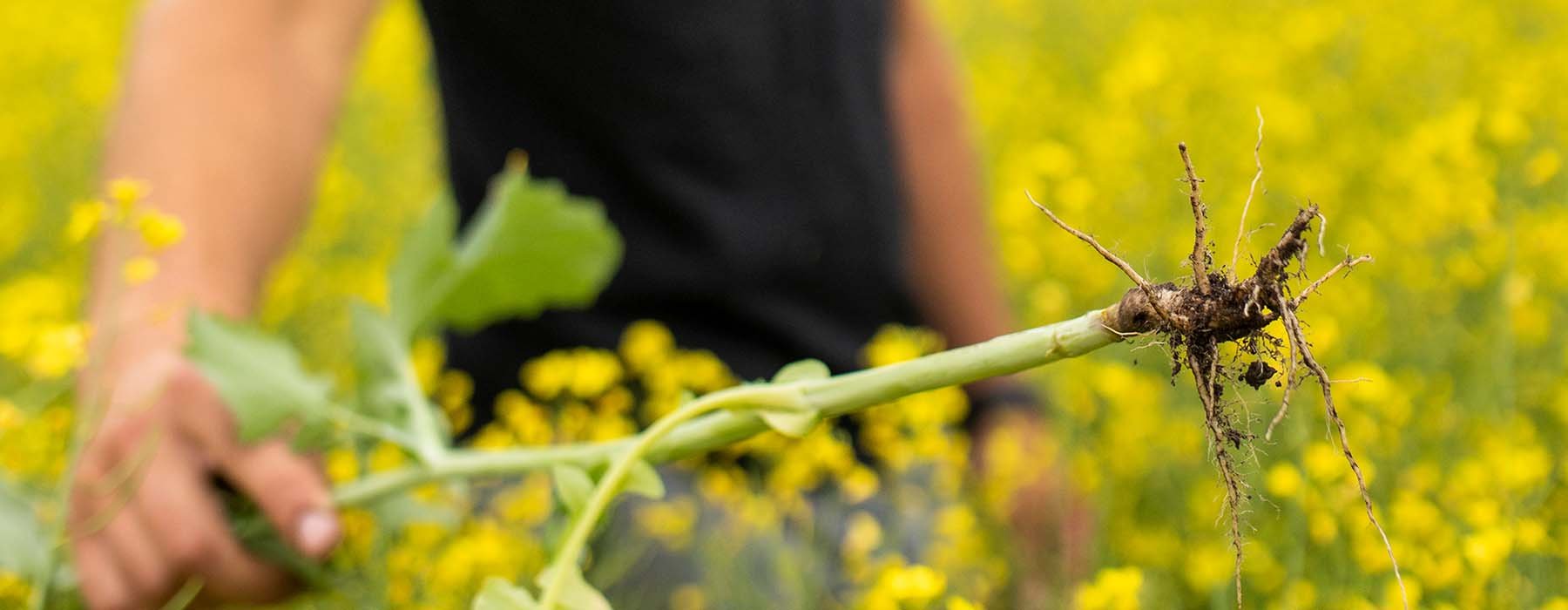
Disease Testing Program
SaskCanola, in partnership with the Saskatchewan Ministry of Agriculture, is ensuring growers have the tools they need to detect the most devastating canola diseases on their farm. The current disease monitoring program now includes verticillium testing in addition to clubroot and blackleg testing. Details below provide information about how to participate.
Clubroot Soil Testing
The Clubroot Soil Testing program supports growers by helping you identify the presence of clubroot on your farm, its invasiveness and methods for control. Results, at the rural municipality (RM) level, will contribute to the Clubroot Distribution Map to guide proactive biosecurity and management decisions province wide.
Findings of clubroot and the clubroot pathogen will be added to the Saskatchewan Clubroot Distribution map (at an RM level). Because of the value that these test results will provide growers and the industry, SaskCanola will cover the cost of each test.
How to Request a Clubroot Soil Test:
Request a soil sampling bag:
Contact the SaskCanola office
Contact your local SARM Plant Health Officer; or
Contact your local Ministry of Agriculture Regional office
*Agronomists who would like to have a bundle of soil testing bags on-hand for clients, should contact SaskCanola.
When to Sample – Soil samples should be collected in late summer or around swathing time. This is when clubroot galls start decomposing and releasing spores back to the soil.
Where to Sample – To reduce the risk of a false negative, it is important to collect soil from high clubroot risk areas. These areas include field entrances, high-traffic areas, water runs and low spots.
Submitting the Sample – Soil samples can be dropped off at your local Ministry of Agriculture regional office or at Discovery Seed Labs, 450 Melville Street, Saskatoon. Make sure that the information form on the sample bag is completely filled out.
Getting the Results – The results will be available in early winter, and a ministry staff member will contact you via email or phone with your results. Results will be kept confidential and will only be shared with the submitting producer/agrologist.
For More Information – Contact your Crop Extension Specialist, call the Agriculture Knowledge Centre’s general inquiry line toll-free at 1-866-457-2377, or see the Government of Saskatchewan website.
Resources:
Canola Encyclopedia - Clubroot Disease
Canola Research Hub Blog - Canola disease survey to inform risk management in 2022
Blackleg Disease Race & Verticillium Stripe Testing
To be able to select the most appropriate resistant hybrid canola variety, growers must know which blackleg races exist in their fields. The blackleg test offered in this program indicates the absence or presence of Leptosphaeria maculans, the aggressive species causing blackleg. If L. maculans is present, the races of the pathogen will also be identified.
New this year, SaskCanola has added verticillium stripe testing. Since verticillium stripe was first reported in 2014, there is still much to learn about this disease. Research is in progress and the Prairie provinces are encouraged to monitor and scout for this disease. Verticillium stripe can easily be confused with other canola diseases, as it presents similar to blackleg and sclerotinia.
The first 200 registered canola growers who apply are eligible for a free blackleg and verticillium stripe test, as only one sample is needed to test for both diseases.
How to Submit Your Samples for Testing:
Step 1: Collect canola plants suspected of blackleg infection following the Discovery Seed Labs Blackleg Sampling Protocol
Sample at 60% seed colour change while plants are still green (swathing time). Cut just below the crown of the plant into the root material to assess the cross section.
Look for black discolouration at the base of the plant in the root tissue. If a stem looks infected, keep a 2-3 inch piece for blackleg testing only, or if verticillium stripe is suspected either in the cross section of the root or on the stem, keep a longer piece of the stem (the first 9-10” from the crown), including the infected parts and submit it for testing.
Sample 10 random stems, each several paces apart.
Repeat in at least 3 areas spread across the field.
Allow samples to air dry overnight before packaging to avoid excessive fungal growth.
Keep notes on how many stems you surveyed, how many were infected, and in which field samples were collected.
Calculate blackleg disease incidence. For example, in a field where 100 plants were surveyed (20 plants surveyed in each of 5 different areas) and 60 of them exhibited blackleg symptoms, there is a 60% blackleg incidence. The new Blackleg Yield Loss Calculator can help you determine yield loss.
Step 2: Email blacklegtesting@saskcanola.com to receive a free blackleg/verticillium stripe combined testing ID code. Include the following information in your email to SaskCanola:
Identify yourself as either a Grower or an Agronomist
Full name
Farm name
Mailing address
Land location
RM
Valid email address to receive test results
Step 3: Fill out the Discovery Seed Labs Blackleg Analysis Request Form.
Step 4: Package air dried samples in a brown paper bag. Label the bag with the sample testing ID code received from step 2 and sampling date. Mail to Discovery Seed Labs along with the Discovery Seed Labs Blackleg Analysis Request Form from step 3.
Mailing address:
Discovery Seed Labs
450 Melville St
Saskatoon, SK S7J 4M2
Results: SaskCanola or the Saskatchewan Ministry of Agriculture will email you the test results, indicating the absence or presence of Leptosphaeria maculans, the aggressive species causing blackleg. If L. maculans is present, the races of the pathogen will also be identified. Verticillium stripe results will be reported as either positive or negative for the disease.
*Note: SaskCanola will share this data with the Canola Council of Canada, the Saskatchewan Ministry of Agriculture, and blackleg researchers, strictly for blackleg race and verticillium stripe monitoring research.
Resources:
CCC Video - How to interpret race tests for blackleg resistance selection
Field Scouting Guide for Producers - Is it Blackleg or Verticillium Stripe?
Canola Encyclopedia: Blackleg Disease
Canola Encyclopedia: Verticillium Stripe Disease
